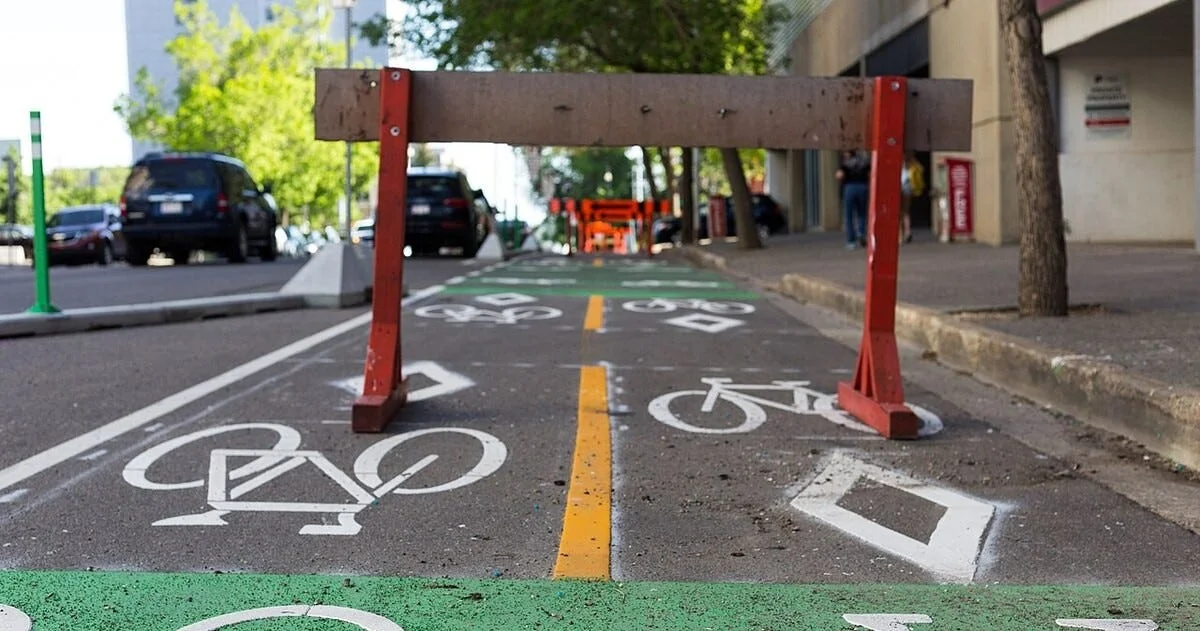Edmonton Scoop
Archives
Edmonton’s Bike Lane Network Expansion: The Full Story
SIGN UP FOR OUR NEWSLETTER
Pavement and Politics: The Battle Over Edmonton’s Bike Lane Network Expansion |
As the city pushes forward with a $100 million active transportation plan, a heated debate erupts between urban visionaries, frustrated drivers, and a provincial government drawing a line in the asphalt. |
Image source: Juno news |
Edmonton’s Bike Lane Network Expansion is about far more than just concrete barriers and green paint.
It is a full-blown battle for the soul of the city’s streets, a conflict pitting a vision of a greener, multi-modal future against the present-day realities of car-dependent commuters.
The city is in the midst of an ambitious, $100 million project, approved by City Council in late 2022, designed to rapidly construct 82 kilometers of new routes by the end of 2026.
This plan aims to fill critical gaps in the existing network, creating safe and connected pathways for cyclists of all ages and abilities.
But as construction crews move into neighborhoods, the project has become a lightning rod for intense debate, sparking community petitions, political maneuvering, and even intervention from the provincial government.
The stakes are incredibly high, defining not just how Edmontonians move, but what kind of city they want to live in.
Advocates, like the vocal YEG Bike Coalition, argue that the investment is long overdue.
They point to studies showing protected bike lanes can reduce the risk of injury by as much as 90% and increase rider confidence, encouraging more people to choose active transportation.
Past projects in the city have already demonstrated a powerful impact, with one University of Alberta study revealing a sixfold increase in stress-free cycling connections after the initial downtown grid was installed.
For supporters, this isn't about inconveniencing drivers; it's about providing choice, improving public health, and meeting Edmonton’s climate goals.
The View From the Driver's Seat and the Front Porch
However, this vision has collided with a wall of resistance.
In communities like the Delton neighbourhood, residents are pushing back hard.
They have organized petitions, citing deep concerns over the loss of on-street parking, potential delays for emergency vehicles, and reduced accessibility for seniors and those with mobility challenges.
Many feel their voices have been ignored in a city-wide push that overlooks the unique character of their streets.
This local frustration has found a powerful ally in the provincial government.
Alberta's Transportation Minister, Devin Dreeshen, has publicly criticized projects that remove vehicle lanes, specifically targeting the renewal of 132 Avenue.
He argues that shrinking road capacity for drivers creates congestion and has even suggested legislation that could require provincial approval for municipal bike lane projects.
The move represents a significant and controversial overreach into municipal affairs, according to some city councillors.
Despite the pressure, Mayor Amarjeet Sohi and a majority of City Council have remained resolute.
In a decisive 9-4 vote in September 2025, the council rejected a motion that would have paused construction on new projects.
The mayor has publicly stated that the city is bound by existing contracts and will move forward with its plans, a sharp rebuke to both provincial pressure and local opposition.
Navigating a City in Transition
The complexity of Edmonton’s Bike Lane Network Expansion is on full display along key corridors.
Take the crucial 102 Avenue route downtown.
Cyclists there are facing a major, multi-year disruption.
The existing bike lane is being temporarily relocated to 103 Avenue until late 2027 to accommodate the massive Valley Line West LRT construction.
This shift is causing headaches for local businesses already concerned about losing the limited on-street parking available.
Further complicating matters, the Wellington Bridge on 102 Avenue is also undergoing a complete replacement, closing a segment of the road entirely until late 2026.
While the new bridge will feature a modern shared-use path, the immediate future is one of detours and disruption, a symbol of the growing pains associated with city-building.
Meanwhile, in historic Old Strathcona, the conversation is expanding beyond just bike lanes.
On bustling streets like Whyte Ave and 83 Avenue, the debate is part of a larger push to create more pedestrian-focused and vibrant public spaces.
Discussions around pedestrianizing sections of Whyte Ave on summer weekends, similar to the atmosphere during the Fringe Festival, are gaining traction.
This signals a fundamental re-imagining of how Edmonton's most iconic streets should function, prioritizing people over vehicles.
For advocates of active transportation Edmonton, this is the ultimate goal: a city where walking and cycling are not just afterthoughts but are woven into the very fabric of urban design.
The Road Ahead is Far From Smooth
While construction is proceeding, the path forward for Edmonton's cycling infrastructure is fraught with challenges.
Progress on the $100 million plan has been slower than anticipated in some areas, with the city citing unforeseen delays related to property acquisition and utility work.
The city remains confident it can catch up and complete all projects by the 2026 deadline, but the political climate remains tense.
The debate is no longer confined to community league meetings; it has become a defining issue in municipal politics and a point of contention between the city and the province.
Every new kilometer of asphalt laid is a victory for some and a profound frustration for others. The conflict is a raw, emotional, and deeply personal one for thousands of residents across the city.
Ultimately, Edmonton’s Bike Lane Network Expansion forces a fundamental question upon its citizens.
Is the disruption, the cost, and the political friction worth the promise of a safer, healthier, and more connected city?
The answer is being written, one protected lane at a time, on the very streets that define Edmonton.
---
FAQ: Edmonton's Bike Lane Expansion
Why is Edmonton expanding its bike lane network? The city is implementing its Bike Plan with a $100 million investment to create a safer, more connected, and year-round active transportation network. The goals are to increase transportation options, improve public health, reduce traffic congestion, and help meet Edmonton's climate action targets by encouraging more people to cycle.
What are the main arguments against the bike lane expansion? Opposition is primarily focused on the removal of vehicle lanes and on-street parking. Critics in neighborhoods like Delton raise concerns about reduced access for emergency vehicles, challenges for residents with disabilities, negative impacts on local businesses, and a perceived lack of community-specific consultation.
Where are some of the key areas for bike lane development and debate? Major projects and debates are centered on several key areas, including the temporary relocation of the 102 Avenue bike lane for LRT construction, the redevelopment of 83 Avenue in Old Strathcona, and provincially-opposed lane reductions on 132 Avenue. The Delton neighbourhood has also become a focal point of resident opposition. |

